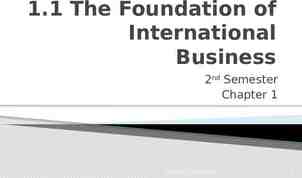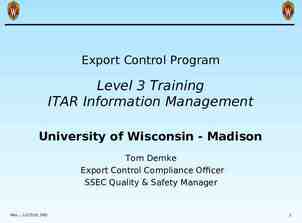International Standards on Drug Use Prevention Dr. Zili Sloboda
32 Slides1.69 MB
International Standards on Drug Use Prevention Dr. Zili Sloboda UNODC Consultant
Intent of the International Standards To summarize the currently available scientific evidence, describing effective interventions and policies and their characteristics. To identify the major components and features of an effective national drug prevention system. Ultimately, to help policy makers worldwide to develop programmes, policies and systems that are a truly effective investment in the future of children, youth, families and communities.
This work builds on and recognizes the work of many other organizations (e.g. EMCDDA, CCSA, CICAD, Mentor, NIDA, WHO) which have previously developed standards and guidelines on various aspects of drug prevention.
Main sections of the Standards Introduction to drug prevention and drug prevention science Evidence-based interventions and policies Components of a national drug prevention system
Prevention is about the healthy & safe development of children, adolescents and adults To avoid or delay the initiation of the use of drugs, or, if started, to avoid progression to drug use disorders such as the dependence. The broader aim is to address drug use by: – helping the healthy and safe development of children and youth to realize their talents and potential becoming contributing members of their community and society. – Effective drug prevention contributes significantly to the positive engagement of children, youth and adults with their families, schools, workplace and community.
The prevention framework
Prevention is socialization
Prevention and socialization Within this framework, prevention – Teaches key socialization agents such as parents and teachers to improve their parenting and teaching skills – Becomes a socialization agent by providing the normative beliefs and life and coping skills to form or reinforce prosocial attitudes and behaviors, to enable children and adolescents to identify and handle high risk situations.
What do we mean by “EvidenceBased”? “Evidence Based Practice (EBP) is the use of systematic decision-making processes or provision of services which have been shown, through available scientific evidence, to consistently improve measurable client outcomes. Instead of tradition, gut reaction or single observations as the basis of decision making, EBP relies on data collected through experimental research and accounts for individual client characteristics and clinician expertise.” (Evidence Based Practice Institute, 2012; http://depts.washington.edu/ebpi/)
Value and limits of available prevention research New and evolving field of prevention science, therefore – Not geographically representative – Efficacy not effectiveness – Possible publication bias – Research is not always current – Lack of standard measures, research designs, and statistical methods
How is the evidence collected? Group of experts (80) identified relevant references for us. Important to note, experts were: – Nominated by UNODC and Member States – Researchers, practitioners, policy makers – Geographically representative
Assessment of the evidence
Infancy and early childhood Children’s earliest interactions occur in the family before they reach school Physical, cognitive, and, emotional development is closely linked to parenting style. During this developmental period children develop strategies and emotional experiences to cope with novelty and threats that form the basis for how they relate to their environment as they grow.
Infancy and early childhood interventions and policies
Middle childhood During middle childhood most often in school and with same age peers. Developmental goals in middle childhood – Age-appropriate language and numeracy skills – Impulse control and self control, goal-directed behaviour, decision making, problem solving – Pro-social attitudes and behaviours, enhanced social and communication skills, self-efficacy and selfesteem – Academic self-efficacy, commitment to school, school attendance.
Middle childhood interventions and policies
Short description Parenting skills programmes support parents in being better parents, in very simple ways. A warm child-rearing style, where parents set rules for acceptable behaviours, closely monitor free time and friendship patterns, help to acquire skills to make informed decisions, and are role models has been shown to be one of the most powerful protective factors against substance abuse and other risky behaviours. These programmes can be delivered also for parents of early adolescents. As the reviews largely cover all ages together, and as principles are largely similar, the intervention is only discussed here. These interventions can be delivered both at the universal and at the selective level.
Evidence Nine good reviews and 4 acceptable reviews. Family-based universal programs prevent alcohol use in young people, the effect size being small but generally consistent and persistent into the medium and long term. Can prevent self-reported drug use at a follow up of 12 months or more. May be the most potentially effective for vulnerable young people and for young people exhibiting multiple risk factors in producing long term reductions in substance abuse. Produce significant and long term improvements with regard to family functioning (including parenting skills and child behaviour), and may also improve the behaviour, and the emotional and behavioural adjustment of children under the age of 3 years. Evidence of cost-effectiveness. Parenting programmes have been implemented in Africa, Asia, the Middle East and Latin America, but only few of these are designed to prevent emotional and behavioural outcomes and/or have a strong methodological design. Barlow, 2005; Bühler, 2008; Foxcroft, 2011; Furlong, 2012; Gates, 2006; Jones, 2006; Knerr, 2013; McGrath, 2006; Mejia, 2012; Miller, 2012; Petrie, 2007; Spoth, 2008; Thomas, 2007.
Characteristics associated with positive prevention outcomes in the evidence Enhance family bonding, i.e. the attachment between parents and children; Support parents on how to take a more active role in their children’s lives, e.g., monitoring their activities and friendships, and being involved in their learning and education; Support parents on how to provide positive and developmentally appropriate discipline; Support parents on how to be a role model for their children.
Additional characteristics associated with positive prevention outcomes Organised in a way to make it easy and appealing for parents to participate (e.g. out-of-office hours, meals, child care, transportation, small prize for completing the sessions, etc.); Typically include a series of sessions (often around 10 sessions, more in the case of work with parents from marginalised or deprived communities or in the context of a treatment programme where one or both parents suffer from substance dependence); Typically include activities for the parents, the children and the whole family; Delivered by trained individuals, in many cases without any other formal qualification.
Characteristics associated with no or negative outcomes Undermine parents’ authority; Use only lecturing as a means of delivery; Provide information to parents about drugs so that they can talk about it with their children; Focus exclusively on the child; Delivered by poorly trained staff.
Existing guidelines and tools for further information UNODC (2010), Compilation of Evidence-Based Family Skills Training Programmes, United Nations Office on Dr ugs and Crime, Vienna, Austria. UNODC (2009), Guide to implementing family skills traini ng programmes for drug abuse prevention, United Natio ns Office on Drugs and Crime, Vienna, Austria. CCSA (2011), Strengthening Our Skills: Canadian guidelines for youth substance abuse prevention family skills programs, Canadian Centre on Substance Abuse, Ottawa, ON, Canada.
Early adolescence This is a developmental period when youth are exposed to new ideas and behaviours. It is a time to “try out” adult roles and responsibilities. Significant changes occurring in the adolescent brain also creates an opportune time for poorly thought out decisions and involvement in potentially harmful behaviours A time when the “plasticity” and malleability of the brain allows for interventions to reinforce or alter earlier experiences.
Early adolescence interventions and policies
Adolescence and adulthood As adolescents assume more adult roles, they can be reached in settings other than the family and the school, such as the workplace, the health sector, entertainment venues and the community. The same evidence that applies to interventions and policies in schools for early adolescents apply to the same interventions and policies when developed for older adolescents
Adolescence and adulthood interventions and policies
Adolescence and adulthood interventions and policies
No evidence (yet?!) Sports and other leisure time activities Prevention of the non-medical use of prescription drugs Interventions and policies targeting children and youth particularly at risk – Out-of-school children and youth, street children, current and ex-child soldiers, displaced or postconflict populations, children and youth in foster care, in orphanages, in the juvenile justice system. Prevention of the use of new psychoactive substances not controlled under the Conventions.
Sustainability Drug use and other related risky behaviours are the end-points of a long process that often begins in early or middle childhood, manifested in adolescence, and has long term implications in the assumption of adult roles as parents, workers, citizens Drug use prevention warrants that availability of multiple interventions that are repeated for each subsequent generation How can that be done effectively?
Infrastructure to sustain prevention A home within existing system of ministries/ departments that have the health and welfare of children and adults as their mandate; The input of key stakeholders (e.g., schools, NGOs, health care organizations, law enforcement); Committed and long-term funding; Supportive regulatory systems; Trained prevention practitioners; Support of research to monitor the drug use situation and to evaluate the prevention programs. IN OTHER WORDS, AN INTERGRATED NATIONAL DRUG PREVENTION SYSTEM
National drug prevention system





































